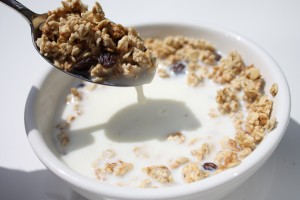 cks have a greater chance of living longer if they increase their dietary intake of fibre – with cereal fibres especially beneficial, research from the Harvard School of Public Health has found.
cks have a greater chance of living longer if they increase their dietary intake of fibre – with cereal fibres especially beneficial, research from the Harvard School of Public Health has found.The research, which was published in the online journal BMJ on 29 April 2014, found that those who ate the most fibre had a 25 per cent lower chance of dying in the nine years after their heart attack compared with those who ate the least fibre. Every 10g per day increase in fibre intake was associated with a 15 per cent reduced risk of dying over the nine-year follow-up period.
The researchers said that with more people surviving heart attacks, it would be increasingly important to find out what lifestyle steps people can take alongside their medication to improve long-term health prospects.
It is well-known that high dietary fibre intake reduces the risk of developing coronary heart disease in healthy individuals. However, until now it was unclear whether increased fibre intake would help heart attack survivors live longer.
Study method
The research team analysed data from two big US studies, the Nurses’ Health Study of 121,700 female nurses and the Health Professional Follow-up Study of 51,529 male health professionals. In both studies, the participants completed detailed questionnaires on their lifestyle habits every two years.
The researchers looked at the 2,258 women and 1,840 men who survived a first myocardial infarction (MI) – a heart attack – during the course of the studies. They were followed for an average of almost nine years after their heart attack, during which time 682 of the women and 451 of the men died.
Participants were divided into five groups (quintiles) according to how much fibre they ate after their heart attack. When considering only cardiovascular causes of death (heart attack, stroke and coronary heart disease), the top quintile had a 13 per cent lower mortality risk compared with the bottom quintile.
When the researchers looked at the three different fibre types – cereal, fruit and vegetable – only higher cereal fibre intake was strongly associated with an increased chance of long-term survival after a heart attack. Breakfast cereal was the main source of dietary fibre.
All the results were adjusted for other factors that might affect the chance of survival after a heart attack, including age, medical history and other dietary and lifestyle habits.
Heart attack survivors more motivated to change lifestyle
The researchers said that heart attack survivors have a higher risk of dying than the general population and were often more motivated to make changes to their lifestyle. However treatment to improve their chances of living longer generally neglects the importance of a healthier lifestyle in favour of long-term medication.
“Future research on lifestyle changes post-MI should focus on a combination of lifestyle changes and how they may further reduce mortality rates beyond what is achievable by medical management alone,” the researchers said.
How fibre helps
High dietary fibre intake can improve blood lipid levels and reduce the risk of high blood pressure, obesity and diabetes while a low-fibre diet is associated with an increased risk of colorectal cancer.
Researchers said less than 5 per cent of Americans consumed the minimum recommended fibre intake of 25g per day for women and 38g per day for men. In the UK, adults are recommended to eat at least 18g of fibre daily but dietary surveys suggest people eat an average of only 14g.





